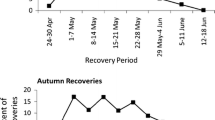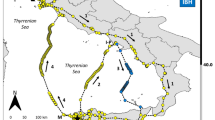Abstract
In 3 different years we glued 29-g satellite transmitters to the back feathers of five Atlantic puffins Fratercula arctica breeding in Røst, southwest of the Lofoten Islands. The birds were tracked for a mean of 26 (range 7–46) days, and four were re-sighted (without transmitters) at their nest sites in the following year. The trajectories documented a unidirectional post-breeding migration towards the Barents Sea, completely opposite of that indicated by all but 1 of the 27 existing ring recoveries of adult puffins from colonies in North Norway outside the breeding season. We discuss the importance of what seems to be a regular visit to the Barents Sea in early autumn for puffins from Røst, which is still one of the largest puffin colonies in the world.


Similar content being viewed by others
References
Anker-Nilssen T (1987) The breeding performance of Puffins Fratercula arctica on Røst, northern Norway in 1979–1985. Fauna norv Ser C Cinclus 10:21–38
Anker-Nilssen T (1992) Food supply as a determinant of reproduction and population development in Norwegian Puffins Fratercula arctica. PhD thesis, University of Trondheim, Norway
Anker-Nilssen T (1994) Lunde Fratercula arctica. In: Gjershaug JO, Thingstad PG, Eldøy S, Byrkjeland S (eds) Norsk Fugleatlas. Hekkefuglenes utbredelse og bestandsstatus i Norge (Atlas of Norwegian breeding birds). Norwegian Ornithological Society, Klæbu, Norway, pp 258–259 (in Norwegian)
Anker-Nilssen T (1998) The population ecology of puffins at Røst in 1998. NINA Oppdragsmelding 571. Norwegian Institute for Nature Research, Trondheim
Anker-Nilssen T, Aarvak T (2000) The population ecology of puffins at Røst. Status after the breeding season 1999. NINA Oppdragsmelding 636. Norwegian Institute for Nature Research, Trondheim
Anker-Nilssen T, Aarvak T (2006) Long-term studies of seabirds in the municipality of Røst, Nordland. Results with focus on 2004 and 2005. NINA Report 133. Norwegian Institute for Nature Research, Trondheim
Anker-Nilssen T, Brøseth H (1998) Long-term studies of the breeding biology of puffins at Røst. An update with results from 1995–97. NINA Fagrapport 32, Norwegian Institute for Nature Research, Trondheim
Anker-Nilssen T, Lorentsen S-H (1990) Distribution of Puffins Fratercula arctica feeding off Røst, northern Norway, during the breeding season, in relation to chick growth, prey and oceanographical parameters. Polar Res 8:67–76
Anker-Nilssen T, Røstad OW (1993) Census and monitoring of Puffins Fratercula arctica on Røst, N Norway, 1979–1988. Ornis Scand 24:1–9
Anker-Nilssen T, Barrett RT, Bustnes JO, Erikstad KE, Fauchald P, Lorentsen S-H, Steen H, Strøm H, Systad GH, Tveraa T (2007) SEAPOP studies in the Lofoten, Barents Sea area in 2006. NINA Report 249. Norwegian Institute for Nature Research, Trondheim
Anker-Nilssen T, Barrett RT, Bustnes JO, Christensen-Dalsgaard S, Erikstad KE, Fauchald P, Lorentsen S-H, Steen H, Strøm H, Systad GH, Tveraa T (2008) SEAPOP studies in the Barents, Norwegian Seas in 2007. NINA Report 363. Norwegian Institute for Nature Research, Trondheim
ARGOS (2009) Argos User’s Manual. ARGOS CLS, Toulouse, France. http://www.argos-system.org/manual/. Accessed 18 May 2009
Barrett RT, Lorentsen S-H, Anker-Nilssen T (2006) The status of seabirds breeding in mainland Norway. Atl Seab 8:97–126
BirdLife International (2004) Tracking ocean wanderers: the global distribution of albatrosses and petrels. Results from the Global Procellariiform Tracking Workshop, 1–5 September, 2003, Gordon’s Bay, South Africa. BirdLife International, Cambridge, UK
Dragesund O, Hamre J, Ulltang Ø (1980) Biology and population dynamics of the Norwegian spring-spawning herring. Rapports et Procés-Verbaux des Ré-unions de Conseil International pour l’Exploration de la Mer 177:43–71
Durant JM, Anker-Nilssen T, Stenseth NC (2003) Trophic interactions under climate fluctuations: the Atlantic puffin as an example. Proc R Soc Lond B 270:1461–1466
Durant JM, Anker-Nilssen T, Stenseth NC (2006) Ocean climate prior to breeding affects the duration of the nestling period in the Atlantic puffin. Biol Lett 2:628–631
Fauchald P, Tveraa T, Bårdsen BJ, Langeland K (2005) Utbredelsen av sjøfugl i Norskehavet og Barentshavet (Distribution of seabirds in the Norwegian and Barents Seas). NINA Rapport 64, Norwegian Institute for Nature Research, Trondheim (in Norwegian)
Fauchald P, Lorentsen S-H, Systad GH, Tveraa T (2006) Utbredelsen av sjøfugl i Skagerrak, Kattegat og Nordsjøen (Distribution of seabirds in the Skagerrak, Kattegat and North Sea). NINA Rapport 171, Norwegian Institute for Nature Research, Trondheim (in Norwegian)
Gaston AJ, Jones IL (1998) The Auks Alcidae. Oxford University Press, Oxford
Hamel NJ, Parrish JK, Conquest LL (2004) Effects of tagging on behavior, provisioning, and reproduction in the common murre (Uria aalge), a diving seabird. Auk 121:1161–1171
Harris MP, Anker-Nilssen T, McCleery RH, Erikstad KE, Shaw DN, Grosbois V (2005) Effect of wintering area and climate on the survival of adult Atlantic puffins Fratercula arctica in the eastern Atlantic. Mar Ecol Prog Ser 297:283–296
Hatch SA, Meyers PM, Mulcahy DM, Douglas DC (2000) Seasonal movements and pelagic habitat use of murres and puffins determined by satellite telemetry. Condor 102:145–154
Hjermann DØ, Stenseth NC, Ottersen G (2004) Indirect climatic forcing of the Barents Sea capelin: a cohort effect. Mar Ecol Prog Ser 273:229–238
Kasper T, Alerstam T, Hake M, Kjellén N (2006) Travelling or stopping of migrating birds in relation to wind: an illustration for the osprey. Behav Ecol 17:497–502
Lid G (1981) Reproduction of the Puffin on Røst in the Lofoten Islands in 1964–1980. Fauna norv Ser C Cinclus 4:30–39
Meyburg B-U, Gallardo M, Meyburg C, Dimitrova E (2004) Migrations and sojourn in Africa of Egyptian vultures (Neophron percnopterus) tracked by satellite. J Ornithol 145:273–280
Meyburg B-U, Meyburg C, Mizera T, Maciorowski G, Kowalski J (2005) Family break up, departure, and autumn migration in Europe of a family of Greater spotted eagles (Aquila clanga) as reported by satellite telemetry. J. Raptor Res 39:462–466
Øyan HS, Anker-Nilssen T (1996) Allocation of growth in food-stressed Atlantic puffin chicks. Auk 113:830–841
Peredes R, Jones IL, Boness DJ (2005) Reduced parental care, compensatory behaviour and reproductive costs of thick-billed murres equipped with data loggers. Anim Behav 69:197–208
Sætre R, Toresen R, Anker-Nilssen T (2002) Factors affecting the recruitment variability of the Norwegian spring-spawning herring (Clupea harengus L.). ICES J Mar Sci 59:725–736
Steenhof K, Fuller MR, Kocherti MN, Bates KK (2005) Long-range movements and breeding dispersal of Prairie Falcons from Southwest Idaho. Condor 107:481–496
Toresen R, Østvedt OJ (2000) Variation in abundance of Norwegian spring-spawning herring (Clupea harengus, Clupeidae) throughout the 20th century and the influence of climatic fluctuations. Fish Fish 1:231–256
Witherby HF, Jourdain FCR, Ticehurst NF, Tucker BW (1941) The handbook of British birds, vol 5. Witherby, London
Acknowledgments
The study received financial support from the Ministry of Petroleum and Energy and the Research Council of Norway. Helpful advice on the telemetry methods was provided by Paul Howey and numerous colleagues around the world who responded to a SEABIRD Listserver request and shared their experiences relevant to the subject. Permission to instrument the puffins in the ways described in this paper was granted by the Norwegian Animal Research Authority and the Directorate for Nature Management and carried out in accordance with the mandatory certification of FELASA category C researchers (TAN) and the appurtenant European Council guidelines for Laboratory Animal Science. We thank Henrik Brøseth and Kjetil Solbakken for assisting in the instrumentation of birds, Tone Kristin Reiertsen for sexing bird 4 by means of PCR amplification, Olav J. Runde and Vidar Bakken for providing the ring recovery data, and Rob Barrett, Anders Mosbech and two anonymous referees for valuable comments to the manuscript.
Author information
Authors and Affiliations
Corresponding author
Rights and permissions
About this article
Cite this article
Anker-Nilssen, T., Aarvak, T. Satellite telemetry reveals post-breeding movements of Atlantic puffins Fratercula arctica from Røst, North Norway. Polar Biol 32, 1657–1664 (2009). https://doi.org/10.1007/s00300-009-0665-7
Received:
Revised:
Accepted:
Published:
Issue Date:
DOI: https://doi.org/10.1007/s00300-009-0665-7




